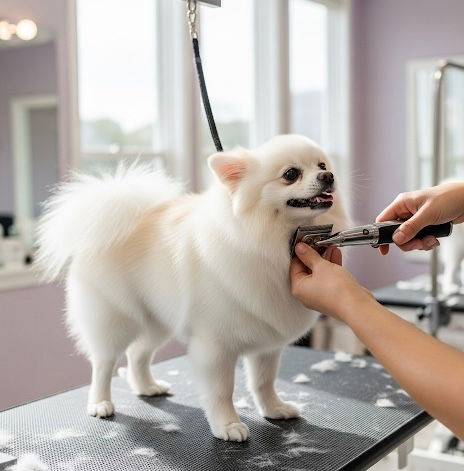Grooming Frequency Guide for Various Dog Breeds What You Need to Know
- mkvujevic
- Jul 23
- 3 min read
Grooming is crucial for your dog's well-being. It's not just about looks; it promotes health, reduces shedding, and strengthens your bond with your furry friend. However, every dog breed has different grooming requirements, which can be confusing for pet owners. This guide will clarify grooming frequencies for various breeds, helping you establish an effective grooming routine for your pet.

Understanding Your Dog's Coat Type
Before examining specific breeds, let's explore the basics of dog coat types. Dogs typically have smooth, wiry, long, or curly coats, each needing a different grooming approach. Generally, a dog with more hair needs more frequent grooming.
For example, breeds like the Shih Tzu, which have long, flowing coats, can mat easily and require daily grooming. In contrast, Beagles, with short fur, may only need weekly grooming to stay in good shape. Knowing your dog's coat type allows you to plan a suitable grooming schedule.
Short-Haired Breeds
Breeds: Beagle, Boxer, Dalmatian
Short-haired breeds require less grooming compared to long-haired types. A weekly brush with a rubber curry comb can effectively remove loose hair and dirt.
Most short-haired dogs only need a bath every couple of months. However, regular grooming is essential for skin health and early detection of potential issues.
For example, Beagles, which are known for their shedding, may shed around 50% of their coat during seasonal changes, making grooming key to managing this.
Recommended Grooming Frequency:
Brushing: Once a week
Bathing: Every 2-3 months
Medium-Haired Breeds
Breeds: Cocker Spaniel, Bulldog, Australian Shepherd
Medium-haired breeds typically require grooming every 1-4 weeks, depending on their coat's condition and whether they have an undercoat. Regular brushing prevents mats and keeps their fur healthy.
Many owners find that grooming tools like slicker brushes or de-shedding tools work wonders, especially during shedding seasons when these dogs can lose up to 25% of their coat. Bathing can usually occur every 1-2 months, based on how active they are and how dirty they get.
Recommended Grooming Frequency:
Brushing: Every 1-4 weeks
Bathing: Every 1-2 months
Long-Haired Breeds
Breeds: Shih Tzu, Yorkshire Terrier, Afghan Hound
Long-haired breeds need the most grooming to prevent tangling and matting. Daily brushing is recommended to maintain their coat's health.
For instance, a Yorkshire Terrier’s hair can grow up to 6 inches long if not trimmed regularly, making it essential to brush daily. Additionally, a professional groomer should handle these breeds every 4-6 weeks to maintain their style and prevent matting.
Recommended Grooming Frequency:
Brushing: Daily
Bathing: Every 4-6 weeks
Wire-Haired Breeds
Breeds: Fox Terrier, Schnauzer, Cairn Terrier
Wire-haired breeds present unique grooming needs. They typically require "hand-stripping," which is the process of plucking out dead hair to maintain their coat's texture. This should be done every 4-6 weeks, ideally by a professional.
Regular brushing is also important for these breeds to prevent mats and keep the coat in good shape. Bathing should be done sparingly, only when necessary, to preserve their coat’s quality.
Recommended Grooming Frequency:
Brushing: Weekly
Bathing: As needed
Curly-Haired Breeds
Breeds: Poodle, Bichon Frise, Portuguese Water Dog
Curly-haired dogs demand regular grooming to avoid mats. It is advisable to brush them at least every 3 days. Professional grooming every 4-6 weeks helps keep their coats stylish and manageable.
Bathing can be done more often, every 4-6 weeks, depending on their lifestyle. For example, a Poodle that frequently plays in water might require more regular baths to keep their coat healthy.
Recommended Grooming Frequency:
Brushing: Every 3 days
Bathing: Every 4-6 weeks
Factors Influencing Grooming Needs
Several factors affect your dog’s grooming requirements:
Health: Health issues may change grooming frequency. Regular grooming helps spot skin problems or parasites early.
Activity Level: Active dogs enjoying the outdoors can get dirty quickly, requiring more frequent grooming to remove debris.
Seasonal Changes: Many dogs shed more during certain seasons. For example, you may notice an increase in shedding during spring and fall.
Age: Younger puppies may need more grooming to get accustomed to it, while older dogs may require gentler techniques.
Final Thoughts
Grooming is a vital part of your pet's care. The frequency required varies widely based on breed and individual characteristics. By understanding how often to groom different breeds, you can better maintain your dog’s health and appearance.
Adhering to a tailored grooming schedule helps keep your pet without mess and aids in their happiness and well-being. Remember, grooming isn't just about looks; it creates a deeper connection between you and your dog.
For optimal results, always consult with a professional groomer or veterinarian to create a grooming routine that fits your dog’s unique needs. Happy grooming!



Comments